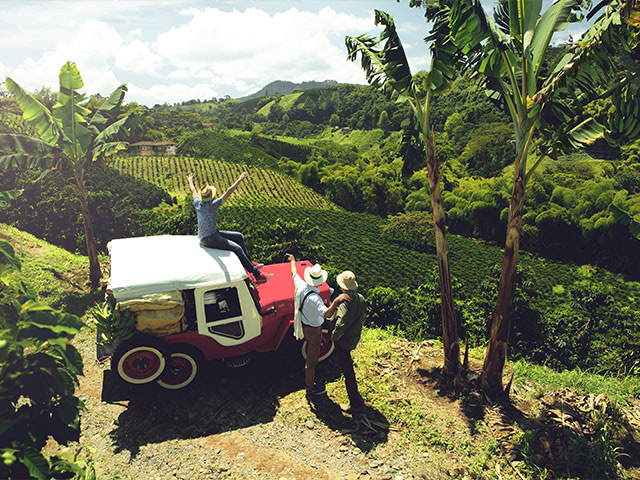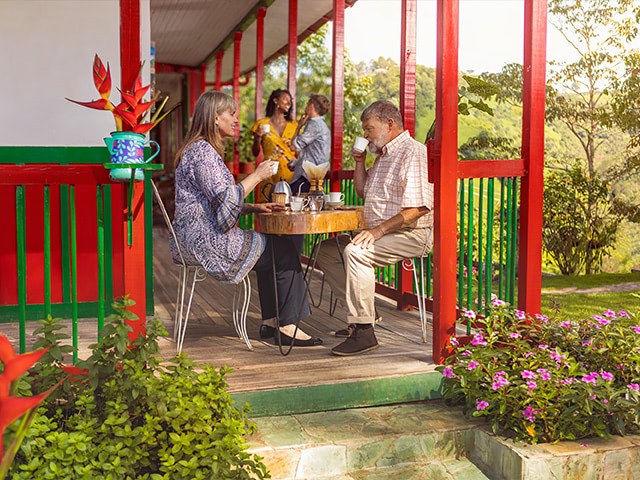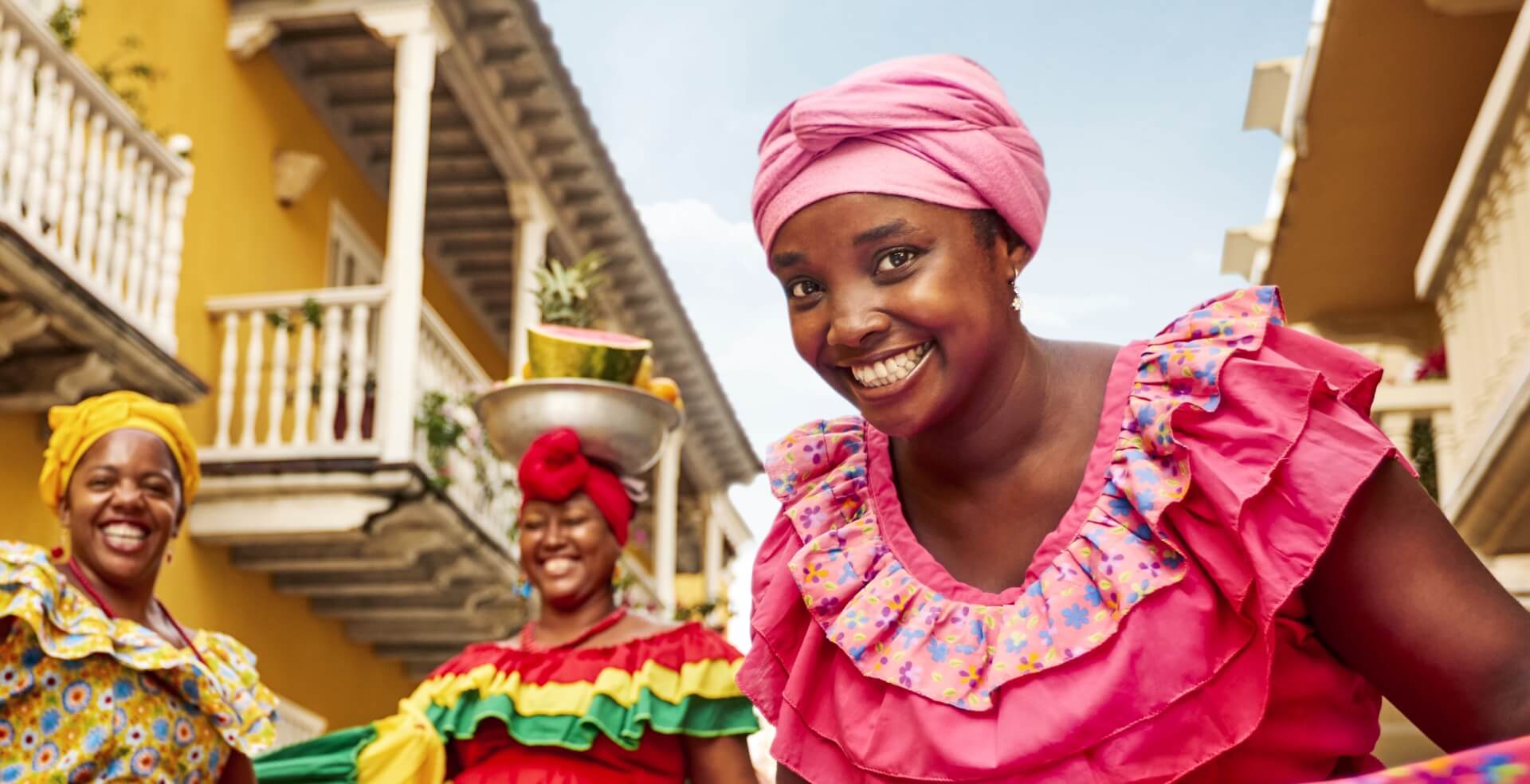Travel through the Colombian coffee route, an unforgettable journey where you’ll meet traditional coffee producers and marvel at Colombia’s stunning scenery.
The Colombian coffee route: The start of an incredible story
Across mountains, valleys, rivers and seas. Along bridle paths and wide highways. Inside airplanes. Such is the journey that coffee, a testament to the hard work and talent of growers in the world’s most welcoming country, takes as it moves from Colombia across the globe.
Why not travel the Colombian coffee route and discover the charms of this great bean in the land where its story begins?
It sounds like a cliché, but the experience is unique: the chance to roam the misty mountains where farmhands pick the freshest beans. Take a walk through the grounds of a pretty hacienda, and grab a front row seat for the roasting. End your day in a comfy chair with a delicious cup of coffee in your hand, watching as the sun sinks behind a mountain peak.
From Cucuta, on Colombia’s border with Venezuela, to the Coffee Cultural Landscape that ecompasses charming towns such as Salento, Filandia, Santa Rosa and Quimbaya, the Colombian coffee route is an incredible experience. Get your camera ready and shout ‘Action!’ with a delicious cup of coffee in your hand.
Landing in the Coffee District

Hundreds of antique Jeeps advance slowly on a high pass between the mountains. People gathered by the side of the road stare as they pass, then cannot resist a photo. Something about these vehicles isn’t quite right, they’re moving on two wheels. It’s an experience straight out of a movie: the famous ‘Yipaos parade’ that takes place twice a year in Calarcá, at the end of June, and the beginning of July.
The “Yipaos” or Willys Jeeps are traditional vehicles in the Coffee Cultural Landscape, an area that, as its name suggests, is famous for the cultivation of this world-conquering bean. Coffee farmers first fell in love with the Jeeps in the 1940s, recognizing in them all the qualities they needed to traverse their mountainous terrain. Over time, they have become iconic, but why the two wheels?
Coffee bags are heavy, so heavy that when these 4x4s are fully loaded, they lean backwards. Gradually drivers in the area “tamed” them and were so proud of their vehicles, and the feats of transportation they could achieve, they began to showcase them. Now Colombians and visitors travel thousands of miles to admire them in parades.
The Colombian coffee route officially begins in the Western Andes, the heart of “Yipao” country. You’ll spot the Jeeps everywhere in this charming part of Colombia, beloved for its mountains, climate and areas of outstanding natural beauty, including the Cocora Valley.
You may also be interested in: Discover the immersive experiences behind a cup of Colombian coffee
Coffee farms: The best cup of coffee you’ve ever tasted

There is no place in the world greater for sampling a world-beating cup of coffee than in the Colombian coffee district, where the bean grows. While a journey along the Colombian coffee route takes in many incredible cities, nothing beats the experience of relaxing on a traditional coffee farm.
Here you can learn about this famous crop, pick your own coffee cherries and inhale their delicious aroma before they’re roasted. Understanding the way the fruit is selected, and how farmers utilize the experience they have garnered through the generations, is living proof that coffee in Colombia is more than just a crop.
Coffee tasting is, of course, the highlight of any trip to a Colombian coffee farm. The country’s growers like to pamper their visitors with a variety of types of coffee to try, and enjoy explaining the different textures, origins, aromas and finishes. From the first mouthful, you’ll feel like a connoisseur – drinking the best coffee you’ve ever tasted.
Other treasures to discover in the Colombian coffee district
There is so much to enjoy in the Coffee Cultural
Landscape, such as a trip to the snow-capped peaks of the Los Nevados National Park, as well as visits to admire the wildlife at the EcoParque Los Yarumos, and the Ukumari Biopark. All of these places demonstrate that the landscapes and scenery along the Colombian coffee route are just as spectacular as their world-famous bean.
Why is Colombian coffee one of the world’s best
Coffee comes to life in Colombia. Every cup has the capacity to delight our palettes with aromas that are sometimes sweet, sometimes sharp, but always with a caramel undertone. Simply raising a cup to our lips and taking a sip is enough to lift the spirits and, more often than not, bring friends and loved ones together.
Colombian coffee has many characteristics and much of its popularity and success is down to Colombia’s different altitudes and thermal floors, as well as its rich soils and perfect geographical positioning, all of which combine to produce a distinctive and delicious flavor.
You’ll notice a difference in taste depending where you go in Colombia, with the country’s different climates, altitudes and rainfall levels all leaving their mark. It’s worth visiting as many coffee destinations as possible, so you can pick your favorite bean and understand its origin story.
You may also be interested in: Coffee Cultural Landscape
Colombia, where coffee is the whole world
Once you’ve explored the Colombian coffee district, make sure to take in some of the country’s other standout coffee destinations. Colombia has more than eight different coffee regions, so your journey will be abundant.
In the north of the country, visit Antioquia, the small town of Minca in the Sierra Nevada de Santa Marta mountains, and the North of Santander. In the center, visit Tolima and the Cauca Valley. In the south, go to Huila, Cauca and Nariño. These destinations come together to create a unique coffee tour, with the cultivation of this famous bean acting as a starting point for various activities.
- Antioquia: Coffee has brought many visitors to this stunning region, and its importance is enshrined in the area’s tourism. Among the many activities on offer in the departmental capital, Medellin, is the chance to visit coffee plantations and learn about their production and processes.
- Minca: The Sierra Nevada de Santa Marta mountains are a land of mystery and charm. This feels like the setting for a movie about lost treasure and it could be – it’s also a place full of natural beauty and ancient wisdom. Visitors are encouraged to hike and go bird-watching, and explore coffee farms with an ecological focus.
A thousand and one ways to say “coffee” in Colombia
Person 1: Hi, good morning, could I please have a “perico”?
Person 2: Hey, could I grab a couple of “tintos” to take away?
Person 3: Hon, could you make mine a “pintadito”?
Persona 4: Brrr, it’s so cold out there, I’ll have a quick “carajillo” please
Even the best student of Spanish couldn’t be expected to understand all those.
Coffee is everything in Colombia, which is why we have so many words for it, and each refers to the way we would like it prepared. You’re going to need to know these terms, so you can enjoy your coffee on the Colombian coffee route to the max. Here’s our handy guide:
Perico:
This is our way of asking for a cup of coffee with milk, which the rest of the world might call a “white coffee” (or a “latte” if made with espresso). The term is used most in Bogota, the capital, so the best place to enjoy a perico is at the top of Monserrate mountain, with a view over the metropolis.
Tinto or tintico:
This causes a lot of confusion with our Spanish friends, for whom “tinto” means wine, especially if we offer them a cup at eight in the morning. “Tinto” in Colombia is a “black coffee” and although “tintico” literally means “small black coffee” it’s just our way of referring to it with affection.
Pintadito:
This literally means “painted” but, for us, it’s a cup of black coffee with a dash of milk - as if you’ve painted it with a splash of white.
Carajillo:
This is a classic Colombian coffee, common in the coldest parts of our country, such as Bogota, Manizales, Pasto and towns such as Villa de Leyva. A carajillo is a cup of coffee with a dash of liquor, such as aguardiente or rum.
You may also be interested in: Coffee culture
A country devoted to its coffee
Coffee is the star of the show in Colombia and, like any movie star, receives its fair share of attention and praise.
There are many kinds of tourism centered around coffee in Colombia, including a visit to the National Coffee Park, near Armenia, which combines coffee history, tasting and education with wildlife encounters and thrilling theme park rides.
In fact, coffee is so important in Colombia that we greet our guests with a “coffee baptism”, a sensual experience that goes beyond taste and enjoyment to a full appreciation of coffee culture, and the work that goes into growing, harvesting and roasting this magical bean.
The best thing about a “coffee baptism” is you don’t need to visit the countryside to experience it. Cities like Bogota, Medellin, Cali and Armenia are ready and prepared to share with you their coffee knowledge and varieties.
Ready to write the script for your journey through the Colombian coffee route?
Enjoy every second!
You may also be interested in: Destinations with flavors that delight



















